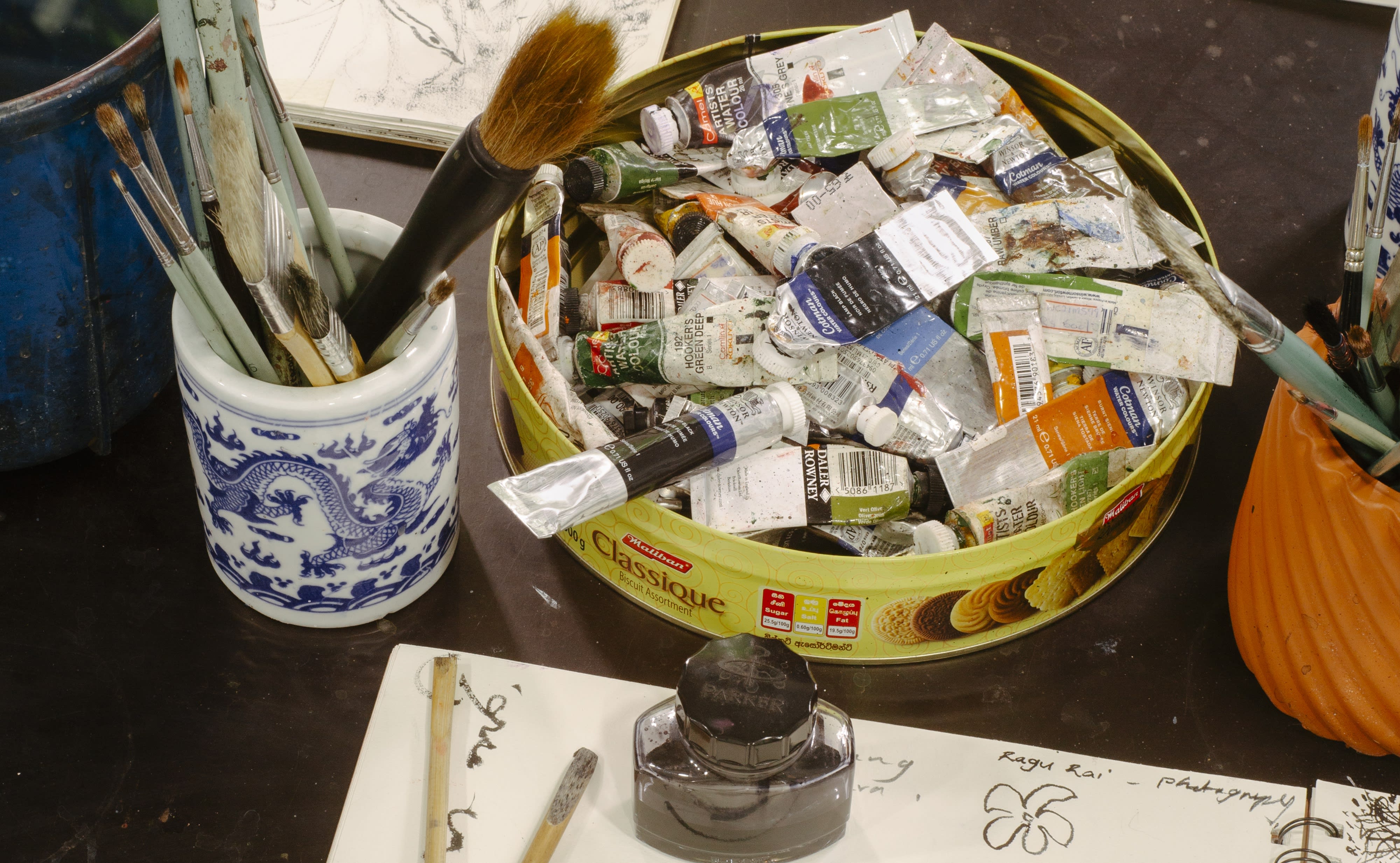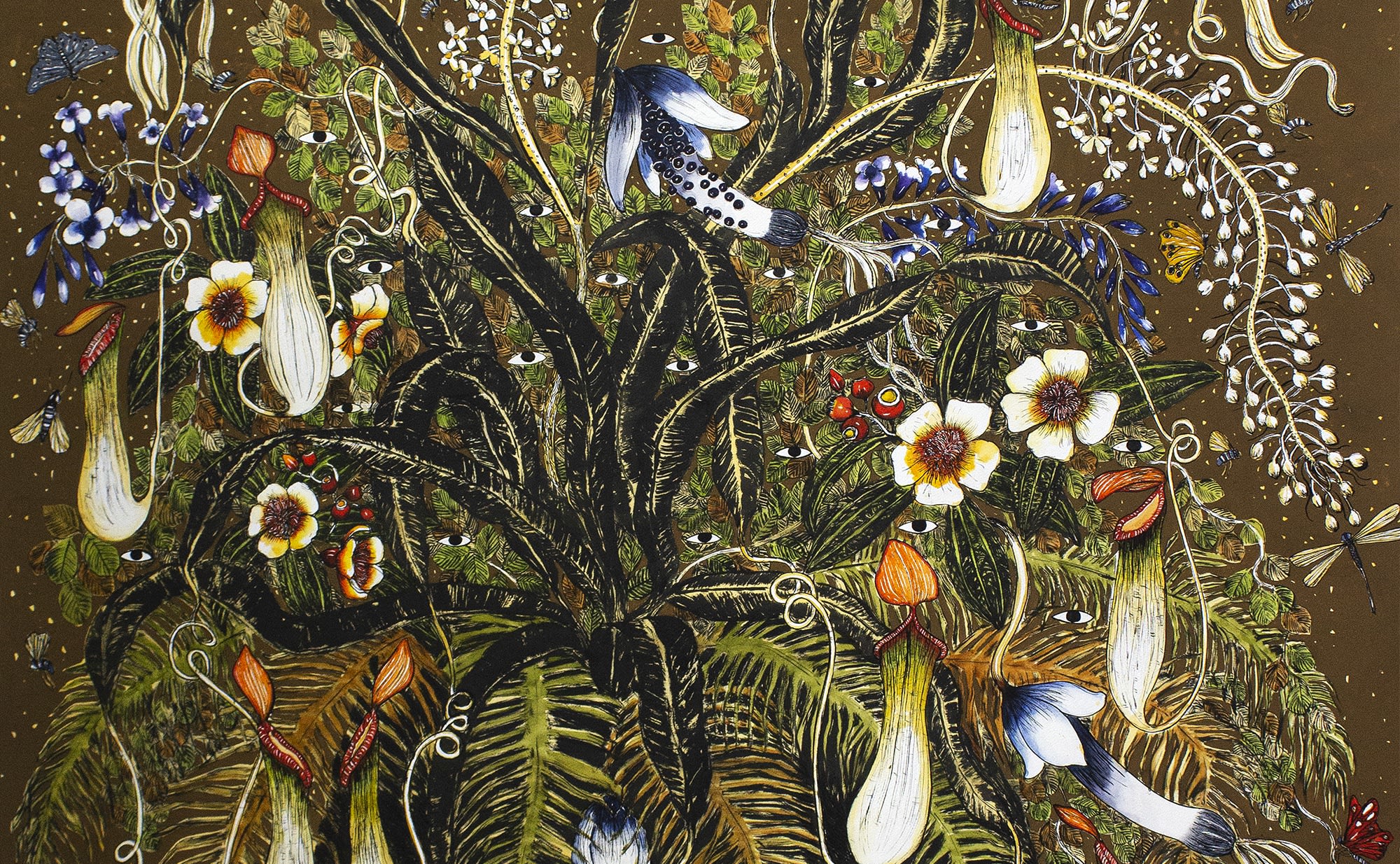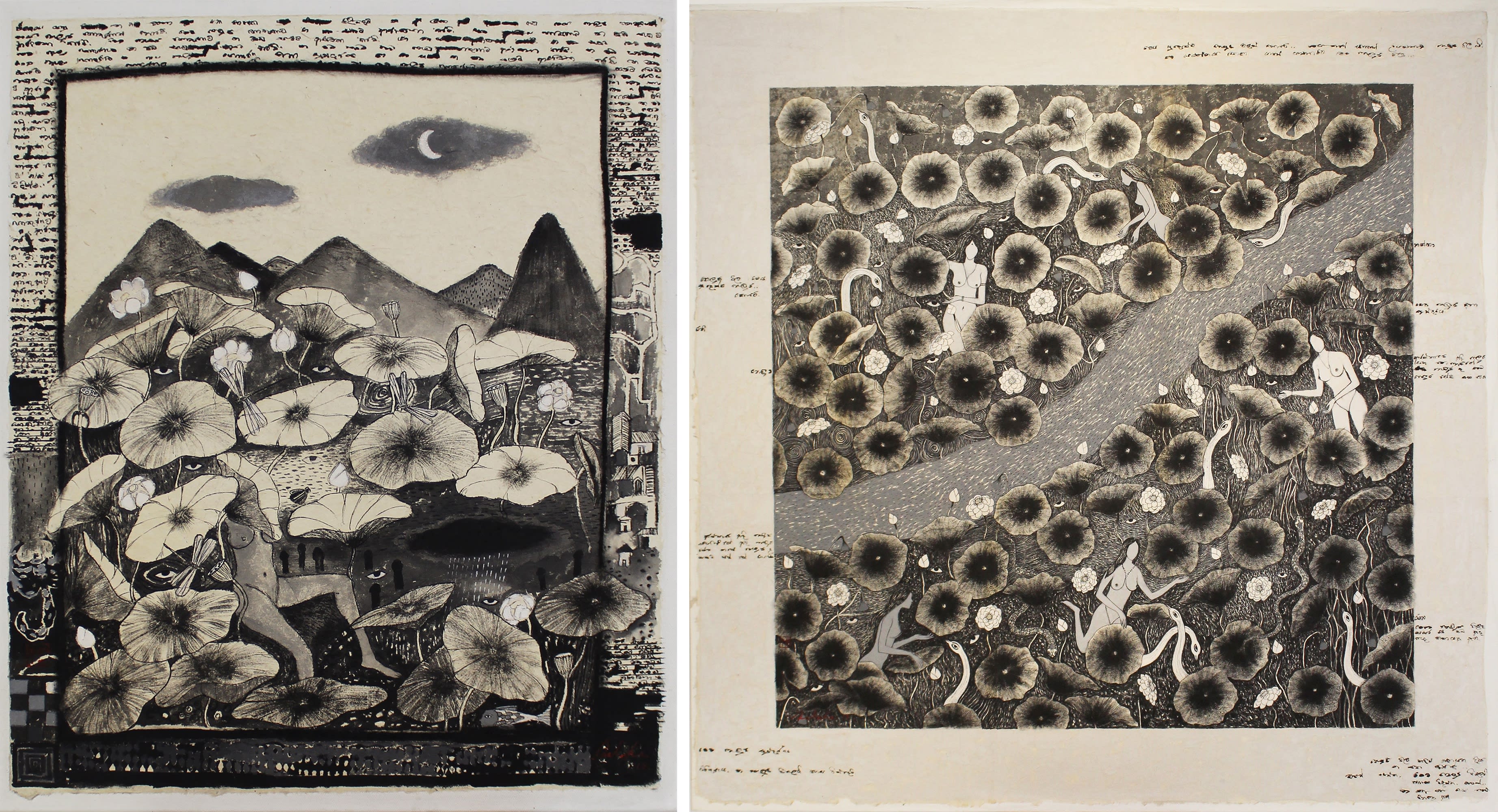
|
Nuwan Nalaka's work is informed by gender, politics, nature, spirituality and psychology. His practice is inspired by the techniques of folk art and traditional painting methods. The artist incorporates calligraphic poetry and bold brush strokes to contrast the minute detail with which he depicts the symbolism and imagery within his canvas and paper works. In his series Sutra (2017) he immerses his thoughts within the microcosm of the lotus pond in order to reflect on the relationship between society and spirituality. In Sansara (2020) the artist presents a stark collection of largely monochromatic paintings while there is a relentless focus on the physical nature of his subject matter and the medium of paint. In his most recent series, Prakriti (2022), he delves into the subject of the sensual and the suggestive through metaphors borrowed from Greek and South Asian imagination.
Nuwan develops the contradictions within his visual narrative through the presence of flora and fauna and continues to question the placement of humanity within his metaphorical landscape through his vibrant formalism.
Nuwan's latest body of work, 'Prakriti' is currently on show at Saskia Fernando Gallery until 13.12.22. |
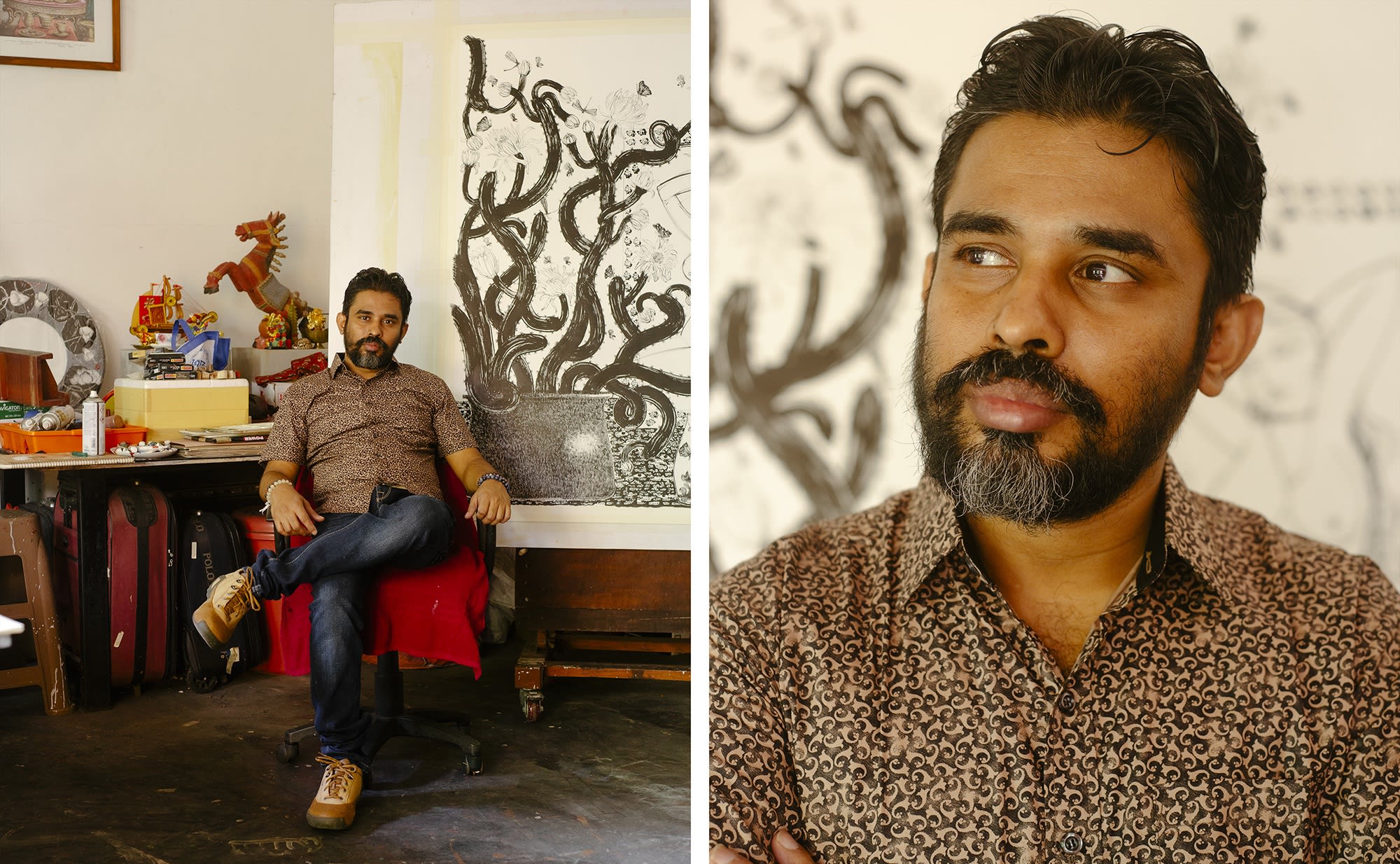 |
| Studio portrait of Nuwan (2022) Photo by: Tavish Gunasena |
WHAT INSPIRES YOU?
I find inspiration in everything that is around me - including nature, the inherent power and beauty of women, the things that occur in contemporary society, everyday life, religious practices - each and every bit of it inspires me.
What is your typical day like?
My day usually begins after four or five hours of sleep. I go to bed around two in the morning. I begin my day by engaging and observing the flowers in my garden, especially the jasmine flowers that I absolutely adore. I take note of the tiny details in the natural surroundings of my home - the greenery, squirrels at play and the bird calls. Everyday, I ritually pick flowers for evening prayers, after which I start work in my studio. It is not just a workspace. It is where I think, ponder upon the ideas that run in my head, or simply recall memories. I make layouts or write down a new idea or concept and I look for references in books, from a range of art, historic tradition or artworks which are parallel to my ideas.
What are your hobbies / what do you do to relax when you’re outside the studio?
|
 |
| Nuwan's studio (2022) |
|
|
|
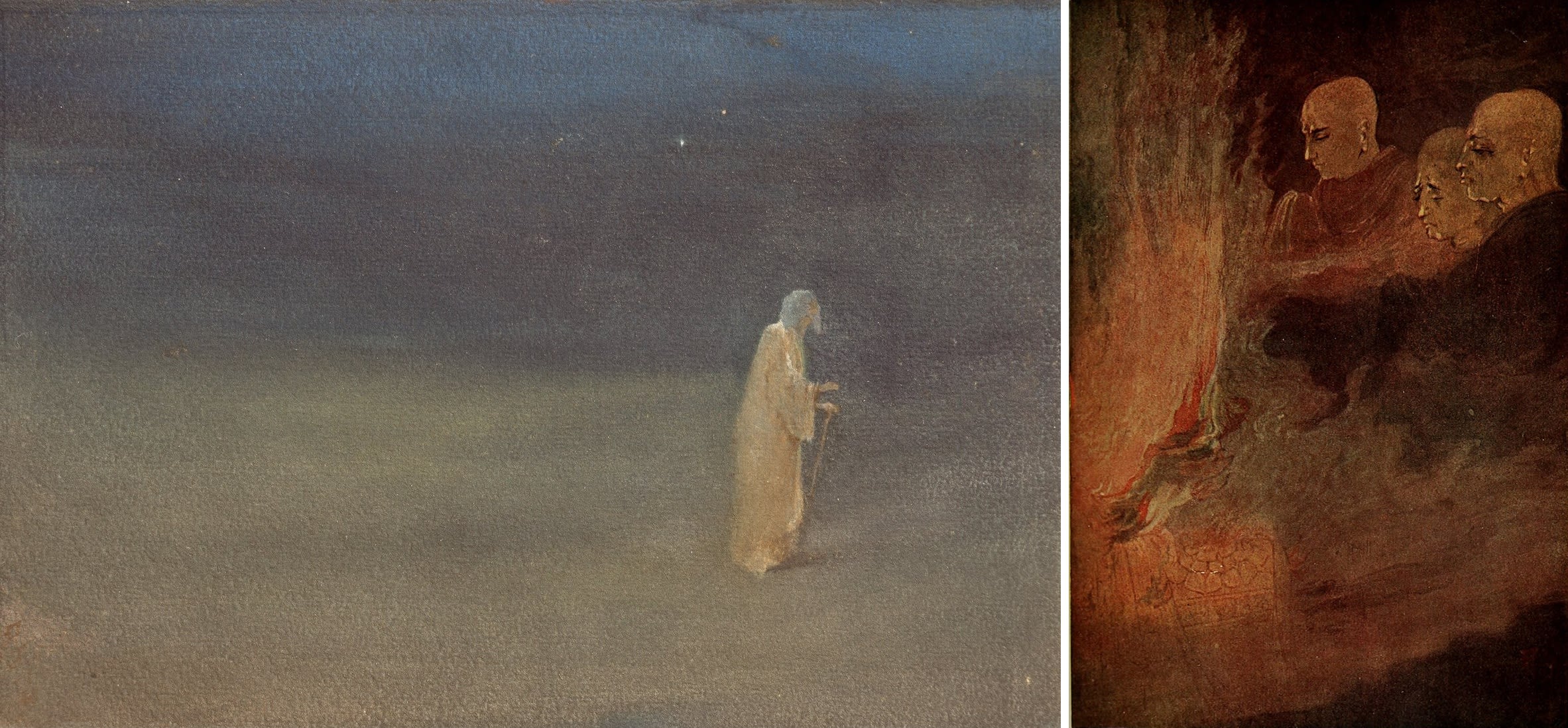 |
|
| Abanindranath Tagore, Rabindranath in the Role of a Blind Singer and Buddha & the Gospel of Buddhism (1916) | |
|
|
|
DO YOU LISTEN TO MUSIC WHILE YOU WORK? IF YES, TELL US WHAT YOU LISTEN TO!
WHAT ARE YOU CURRENTLY READING?I love reading. There was a time when I wouldn’t even eat or drink if I picked up a book. Nowadays, however, I don't have much time on hand to read. I do read when I do have to prepare for lectures. My way around it has been to listen to YouTube. Although I can’t read Bengali, I understand it completely. So I listen to Bengali literature on YouTube. Bengali programs like Sunday Suspense have a range of stories. I don’t miss it. I listen to it while working. Sunday Suspense has stories such as Tara Nath Tantrik, Sherlock Holmes, or short stories by Rabindrandranth Tagore, and Sharandindu Bandhopadhyay. I really enjoy detective stories.I also used to listen to Unlimited History by art historian Raj Somadeva, from the University of Kelaniya.
There are of course times when I turn off everything and just work in silence. |
|
Would you elaborate for us the process of your work - from how you conceptualise an idea to the final execution of the work? What are the techniques that you use?
It is not necessary to use the exact, typical technique of colour application. What I mean is that if one were to look at K.G. Subramanian or George Keyt’s works, you’d notice that they apply colours freely - they are free stroke brush applications. When it came to my exhibition Sutra (2020) for instance, I paid attention to the small details. The series consisted of small flowers, and I had dedicated many hours to it and worked with a lot of concentration which was not as required or rather demanded by Prakriti.
When I work, I don’t make a pencil sketch. Instead, I work directly on the canvas using a brush. The techniques I use are in fact determined by the nature of the work. If I could bring forth an idea by only using black, I opt for it. Oftentimes when we repeatedly apply colour on a work, the essence, which was initially conveyed by the first brushstrokes on the canvas, is lost. Hence, I try to retain the quality and effect which was achieved by the initial brushstrokes. Someone might say that the work is incomplete but for me the work is complete and I am content with it.
|
|
|
| K. G. Subramanyan, Goddess 14 (2007) and Goddess 2 (2000) |
 |
| Nuwan Nalaka, Sansāra (2020) |
|
I use colour depending on the needs and requirements of the work, but I prefer using blacks, whites and ash. Although I can work with colour, I find that a lot can be conveyed through the use of black. It allows me to convey a range of ideas and create a sense of suspense, mystery or make something inconspicuous. It helps me add a certain depth to my work. However, I also don’t like constantly being predisposed to a certain style. I prefer change. That is what I did with Prakriti. |
|
|
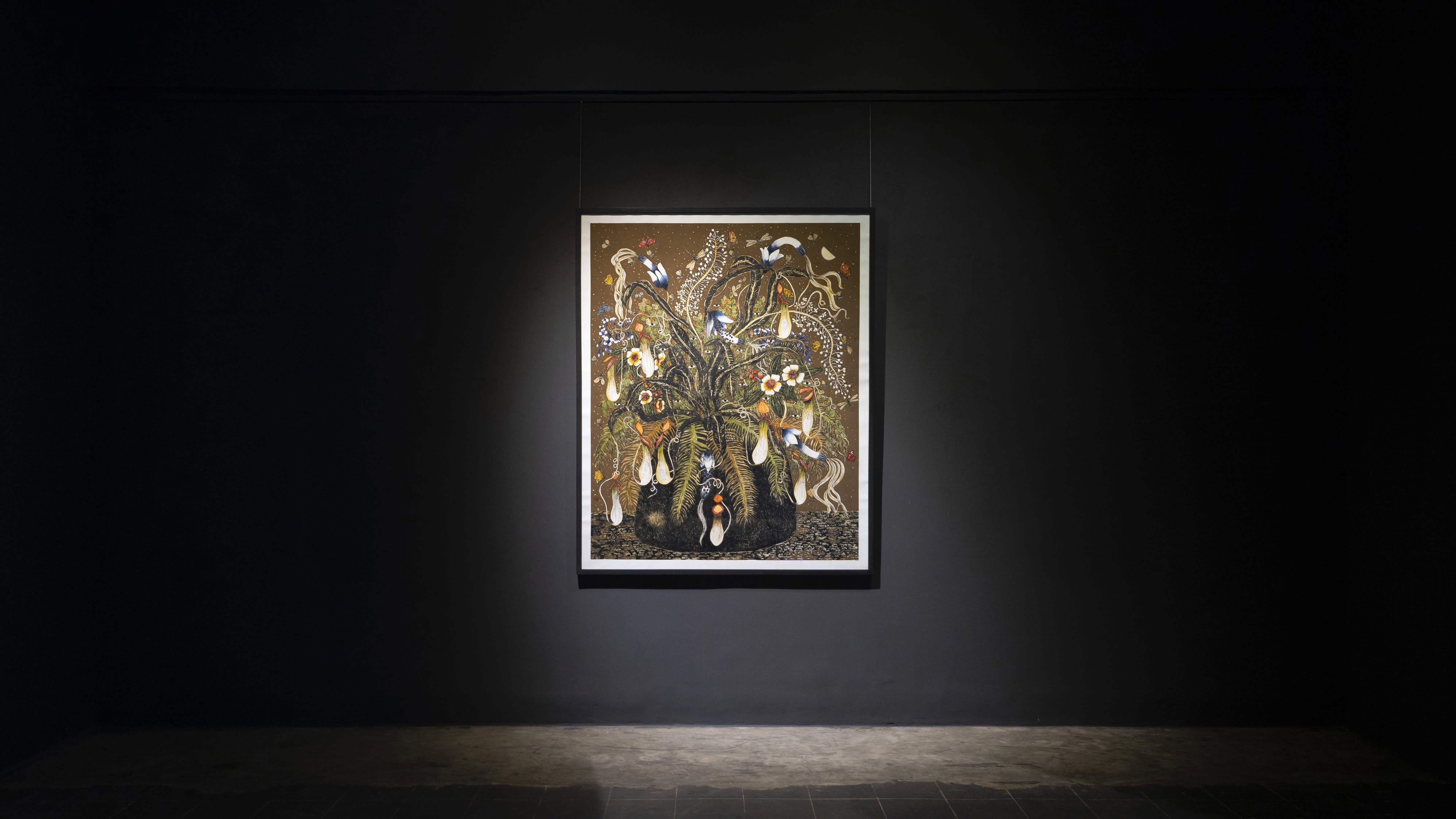 |
| Nuwan Nalaka, Prakriti XI (2022) |
YOU SEEM TO HAVE A DEEP ENGAGEMENT WITH NATURE. COULD YOU ELABORATE A LITTLE ON THAT?
In West Bengal, during my university years, I learnt about the connection that artists shared with nature. Nature study is an important part of the Bengal school of learning. This engagement with nature is also found in Far Eastern art, European art, etc; and each genre has explored it in their own unique ways. I am not an urban child. Throughout my childhood I have worked in paddy fields, and engaged constantly with nature.
I have also found a mysteriousness and beauty in the flowers that bloom in the night. The way you experience a place during day and night is different. The place I lived during my younger years was surrounded by rich vegetation and a liveliness of creatures that inhabit those spaces. Unfortunately today, it has been taken over by buildings. I have found comfort amongst rivers, oceans and areas filled with the verdant green.
|
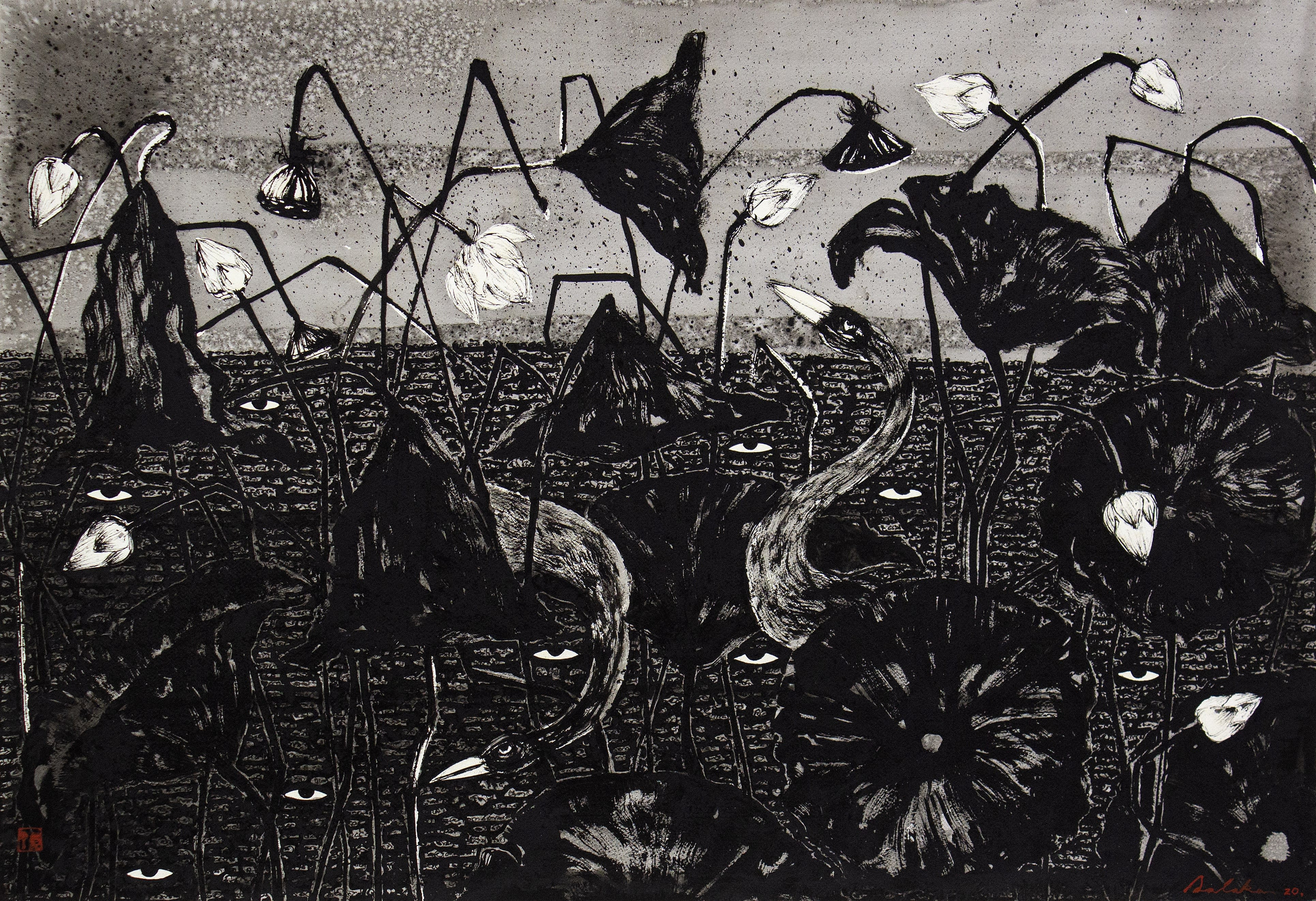 |
| Nuwan Nalaka, Sansāra (2020) |
|
|
YOU MENTION THAT INDIAN AND BUDDHIST PHILOSOPHY INFLUENCES YOUR BODY OF WORK. TELL US ABOUT THE IDEAS WITHIN THESE SCHOOLS OF THOUGHT WHICH INTRIGUE YOU THE MOST.
I am Buddhist. My wife is Hindu, Indian. I am inclined towards learning about Buddhism and meditation, however, I also relate to ideas from Hinduism. I am someone who reads a lot about Tantra, and practises them to a certain extent. For instance, the idea of feminine energy is represented in Hinduism through goddesses such as Saraswati, Lakshmi, Durga, Gayatri, and Radha. I attempt to understand and represent this by including concepts of feminine energy in my paintings. For instance, in the Inner View series, I attempted to bring out the essence and the power of women through the tattoo-like style I used in the work.
I also find that ideas of salvation, moksha or nirvana in Hinduism, Jainism or Buddhism, run parallel to each other. Although they may have arrived at it differently, the ideas that these faiths or philosophies reflect upon are in essence, similar. My attempt is to discover how I can attain Nirvana, as an artist, through my work. Hence, I try to depict my thoughts and the way I philosophise on different subjects in my work.
|
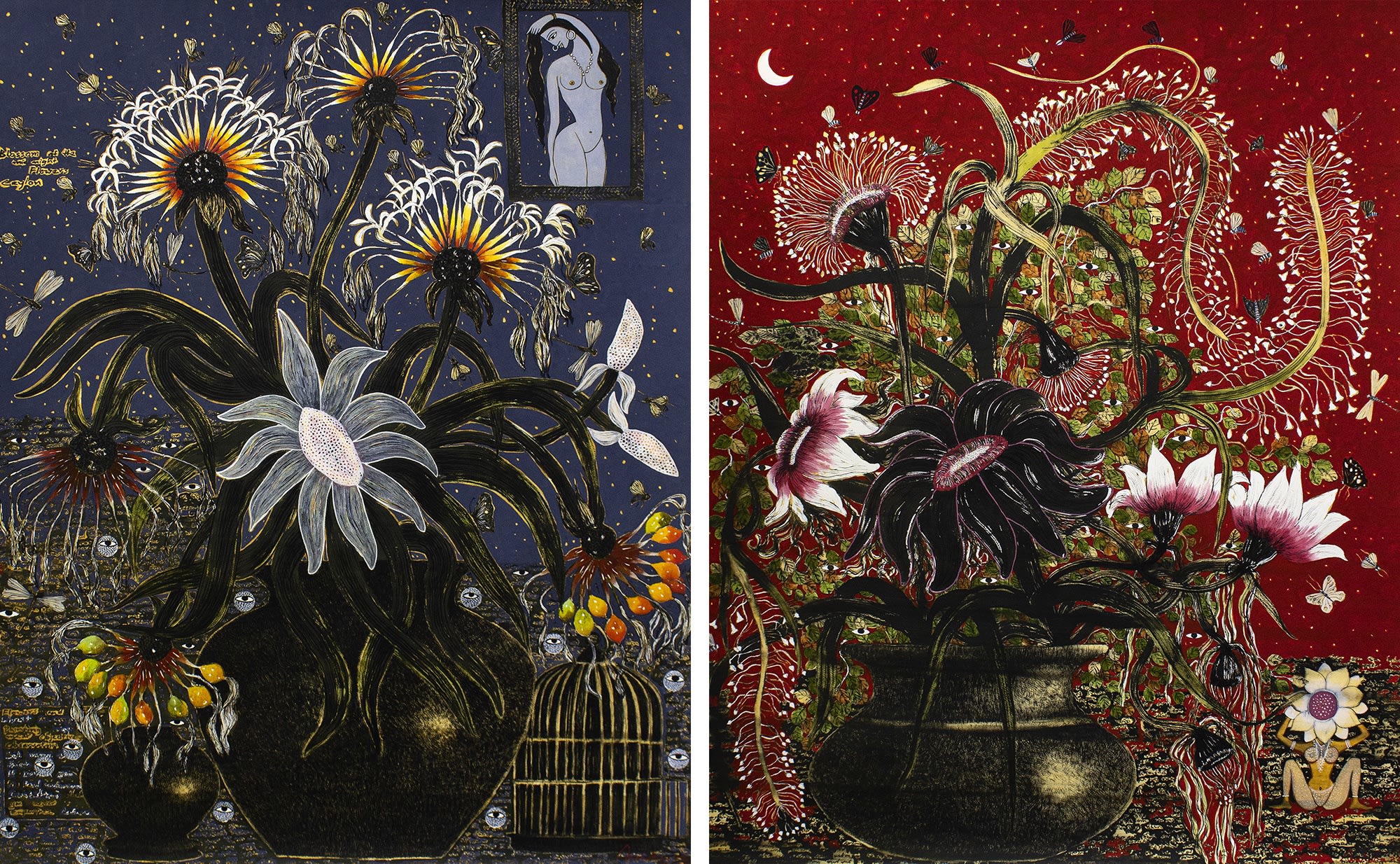 |
|
Nuwan Nalaka, Prakriti II & Prakriti III (2022) |
In your earlier series, Sutra you worked with the Lotus Sutra and the ideas of meditation and enlightenment. Sansara, which followed this, was a reflection on the global pandemic. Both reflected on the relationship between society and spirituality. The more recent series Prakriti, on the other hand, deals with ideas of desire and the sensual. Would you agree that Prakriti holds a starkly opposing position to your previous works? Describe both your creative and mental processes in producing such works.
I don’t see a difference in the ideas that were touched upon through either of the works. Life is the subject of my work.
My work deals equally with the subject of spirituality as much as it does with sexuality. I don’t see nudity or the sexual as something that cannot be talked about. My approach to it is to identify the purity within them. If we look at the history of art, we know that the idea has been explored throughout in the images of the mother goddess, Salabhanjika, Japanese erotic art, Mughal Persian miniature, or even in the works of George Keyt or Jamini Roy. I want to explore and present the erotic with a philosophical tangent. In my opinion the path to Nirvana is not suffering. It is a journey which we move towards by enjoying and experiencing every facet of life. While meditating in the solitude of the Himalayas might be ideal, I also think that we should be able to do so even in the chaos of urban city life. Nirvana is not too far for an individual who can control his senses while he experiences everyday life.
As an individual I am very sensitive. I see my perspective on compassion and humanity as somewhat unique. I also understand that lust and desire are very natural aspects of human life. As an artist, I am concerned with representing these ideas sensitively. If we look at artworks by M.F. Hussain of the Progressive Group we know that he presented these ideas very explicitly. That too is alright. He had painted the goddesses from the Hindu pantheon in the nude which led to much controversy. What I wanted to emphasise is that I do not see nudity or sexuality as something that needs to be hidden or unspoken of. I find purity in the nude figure. It is not possible to accentuate the beauty and elegance contained within the nude figure by draping or covering it. As an artist I prefer expressing these ideas in the purest form possible.
The Khajuraho temples in India are known for their erotic imagery. These figures are on the outer facade of the temple. Indian society is quite conservative. However, if we must contemplate on the purpose of such erotic imagery on the temple, how do we do it? My interpretation is that, if one wishes to attain Nirvana one cannot do so without experiencing all aspects of human life. One must experience the material world, else, one may have to return to complete the cycle of life.
|
 |
| Nuwan Nalaka, Sutra (2017) |
As an individual I am very sensitive. I see my perspective on compassion and humanity as somewhat unique. I also understand that lust and desire are very natural aspects of human life. As an artist, I am concerned with representing these ideas sensitively. |
|
|
| Nuwan Nalaka, Sutra (2017) |
Could you elaborate a bit further on the texts that are present in your work?
I believe we can look at the text in my work in several different ways. Although I have a certain discipline in life, I don’t use diaries. Unfortunately, I don't have the time to write in a diary. The text you see in my work are mostly my ideas and thoughts that I work with. One can say that I moved the practice of writing into my work.
Both Rabindranath Tagore and Abanindranath Tagore used text in their work. For instance, Abanindranth styled Bengali text to look like the Persian script in his works. These two artists have influenced the use of text in my work. Besides this, I also use it to add a certain texture to my work. I write the thoughts and ideas that occur to me while working on my canvas, and if someone happens to read it they would perhaps find more meaning hidden within the words. However, this is not necessary. I sometimes even ask my wife to write something in Bengali. |
 |
|
Left: Abanindranath Tagore, Sinbad the Sailor (1930) Right: Rabindranth Tagore, Where the Mind is Without Fear (1910) |
WHAT IS YOUR FAVOURITE PLACE TO TRAVEL TO?Kolkata. I love the old city. I like the old buildings and structures. I have had a long and strong relationship with the place. I enjoy walking on the aged streets of Kolkata, the trams, the rickshaws… When I am there I often feel that I have travelled back a few centuries.
Do you have any advice for aspiring young artists?To be an artist is difficult. You don’t become an artist by doing a course at a university. You need a certain amount of personal experiences as well. In the past seven years of being a lecturer I have noticed that most students want to become artists. However, what I have noticed is there are a lot of gaps in their practice. They need to develop their practice and grow. One cannot expect to learn all of it within a program at an institution. Hence, we must shape our lives in a way to accommodate that growth. One might have to make a lot of compromises. It requires a lot of commitment and could be immensely challenging too.
Besides the education we get at the university - one must read books, see different things, and be observant. These could be things that are both important and unimportant, necessary and unnecessary. Even when it comes to art they need to engage with all kinds of art. One should develop the skill to read. Practice engaging with works visually, see exhibitions, talk about art, and regularly practise making art. One should give up the idea of creating a piece of work with the objective of selling it the next day. Making art should be more of a daily practice and habit. If one can cultivate these habits and stay committed, then one can be more successful as an artist. However it is also true that in a country like Sri Lanka, it could also be a very big challenge.
What next?I haven’t planned anything yet. I am still thinking about what I would like to work on for the next exhibition. Either way, I want to keep it a surprise. I believe surprises are important for life.
|
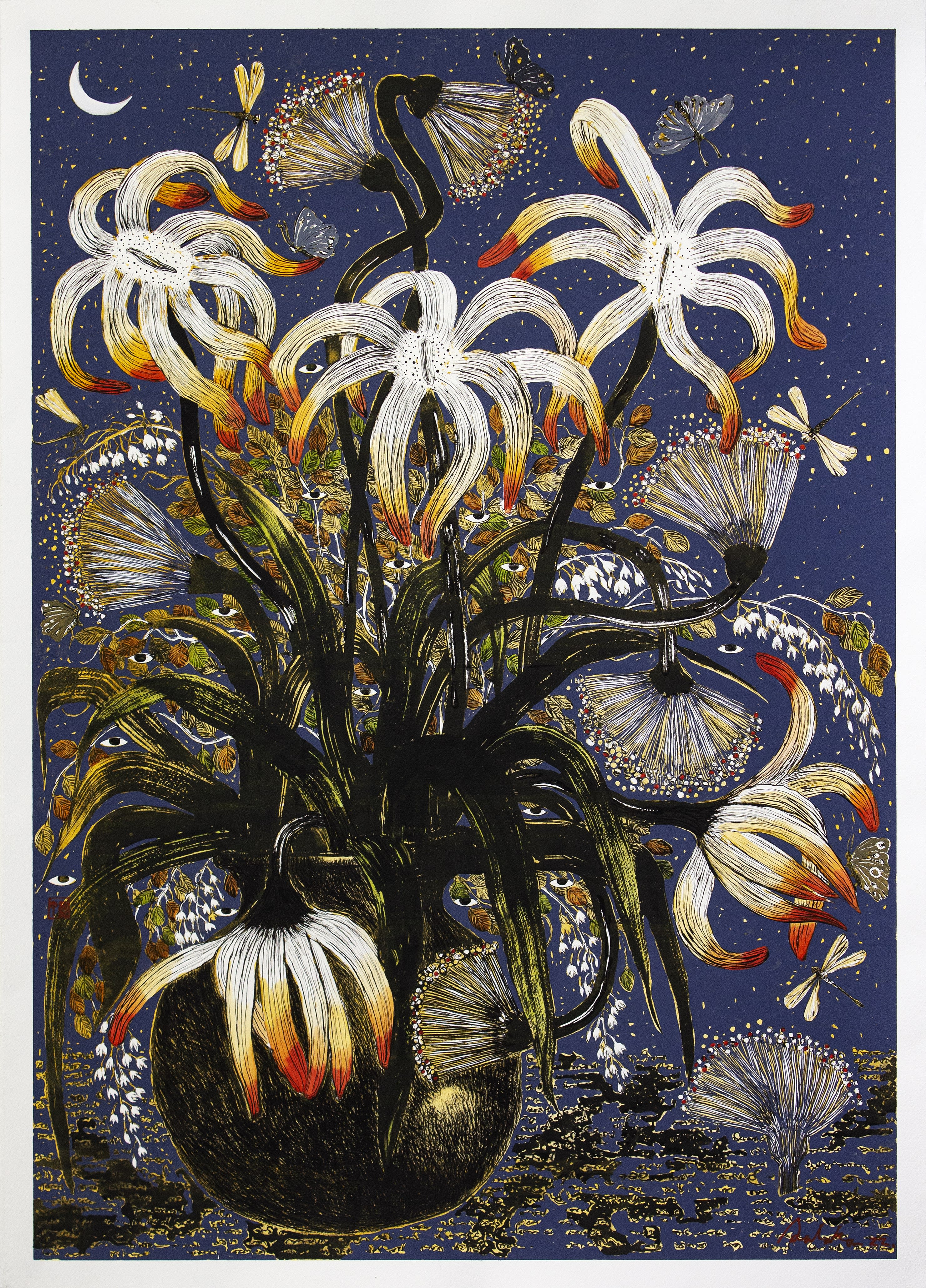 |
| Nuwan Nalaka, Prakriti (2022) |

